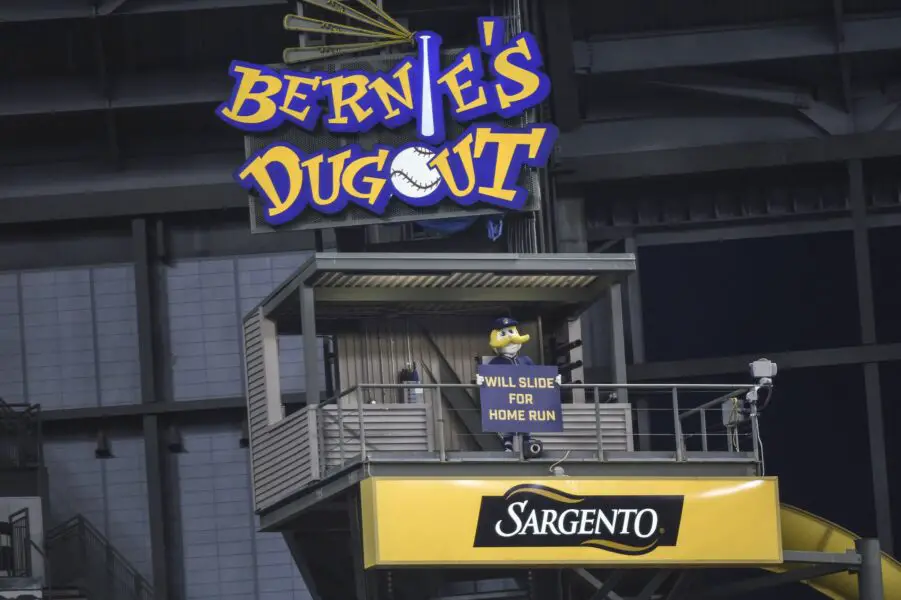Few things can bring together a city like a sports franchise. The thrills of winning an important game or the curse of failure can cause huge celebrations or haunt a city for decades. For many people, their team is part of the family, and for most major league American sports teams, mascots are the face of those teams. That’s true of Milwaukee mascots as much as any other.
We are living in an increasingly digital world. The recent global pandemic and the rapid development of social media and related technology have shown that society increasingly depends on digital interaction and communities for social contact. But how do these digital spaces retain the strength of human connection? And how do major league sports teams utilize mascots in these emerging digital spaces to interact with fans and ignite team spirit?
Milwaukee Mascots Bernie Brewer and Bango the Buck
The task of bringing these personalities to life in interactive, digital environments falls on animators like Arash Rod, who plays a key role in storyboarding and animating Bernie Brewer and Bango the Buck. Mascots do more than just pump up a crowd and lead chants. Many have storylines and other characters that join them. They are there to maintain the game’s energy for the crowd to feed off and be the face of their organization. These are the kinds of things animators must think about, and how to take the essence of personal interaction that mascots provide and bring it into the digital world.
Animation is a field that requires both technical expertise and a creative imagination. Animators like Arash Rod approach the storyboarding and design of these mascots with the same care and attention that a director of a movie or a novelist would apply to a character. Milwaukee mascots have different personalities and histories with the team and are the living embodiment of the relationship between a city and its team.
Take Bernie Brewer, for example. His origins are fan-driven as he arrived in 1970 in the form of Milt Mason, a 69-year old fan who set up camp at the top of the scoreboard and refused to come down until a crowd of over 40,000 showed up for the team, which was in their first year and had yet to become popular. It only took about two weeks for attention to spread around the city and for a crowd of 44,387 fans to show up and bring him down.

Only a few years later, in 1973, Bernie Brewer had grown into a character with his own “chalet,” a part of the stadium where he would lead the crowd. This is a nod to Sweden, their love of beer, and Milwaukee’s strong beer connection. After every home run, he would go down a giant slide into a beer stein. This personality trait comes directly from Milwaukee, having over 30 breweries in its metropolitan area, making it one of the most beer-centric cities in the country. This is a perfect example of how Milwaukee mascots are both the embodiment of the team and the city, linking them together.

Bango the Buck is the mascot for the Milwaukee Bucks and has also developed a personality intimately tied to the city of Milwaukee. The fans themselves voted on his name, and it comes from a phrase used by Eddie Doucette, the original announcer of the Bucks, which he would say every time a Bucks player hit a long-range shot. Bango is an integral part of Milwaukee, making over 250 appearances in the community every year.
The question for animators is how to fully develop Bango the Buck and Bernie Brewer in a digital space that connects with the Milwaukee fandom in the same way that they do in real life. How can AI contain the history that the fans have with the mascots? There is merchandise, which allows fans to download the mascot’s likeness and print it on different objects. But that is just the tip of the iceberg.
Recent advances in technology, though, have created the availability of chatbots. This allows fans to interact with their favorite mascots in real time. The chatbots are not just animated and coded to help sell the Bucks or Brewers brand, but they are sources of team history or trivia. They can help promote events or upcoming games. They now also have the ability to be a part of digital storylines. Animators have the freedom to create a whole world for the mascot to be a part or a whole story to tell. They can create adventures for the mascots to go on, which get the community more involved and more invested in their team.
The development of these chatbots and AI systems goes way beyond just selling the Milwaukee brand. They give a chance to further develop mascots that the city is already intimately invested in. And it brings the mascots and the city even closer because it provides an opportunity for everyday interaction right in the palm of their hand. Considering that both Bernie Brewer and Bango the Buck have over 40,000 followers each across all social media channels (roughly the size of a baseball stadium), it’s clear that people feel very tied to these mascots as part of their city’s identity.
Bearing that responsibility may feel like a lot, but for animators like Arash Rod, it’s an exciting opportunity. It takes a deep knowledge not just of the technical aspects of creating AI but also the creative understanding of how to connect that technology to a city that is passionate about its sports and its Milwaukee mascots!









